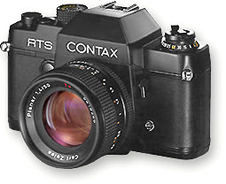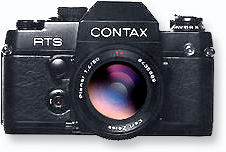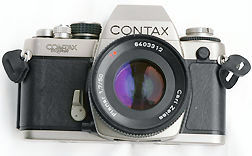Carl Zeiss
Carl Zeiss T*
The Foundation
A related contributing article from Contax Gallery, Malaysia
My favourite series: Contax RTS, Contax RTS II and Contax RTS IIIMotor Drive | Power Winder | Focusing screens | Flash photography | Macrophotography | Remote Photography | Databack options | Accessories
1846-1890 | 1891-1945 | 1946-1960 | 1961-1975 | 1976-1997
| Contax RTS | 1975-1982 - Main Index Page
Instruction Manuals: 6 PartsThe third camera introduced by Yashica to wear the Contax badge was the 137MD, the world's smallest and first integrated motor drive camera. All mechanical functions were controlled by micro-motors. The Contax 137MD offered an aperture preferred automatic exposure mode which could be coupled with an AE Lock to set a specific shutter speed for manual operation. The 137MD was shortly followed by the Contax 137MA which introduced minor changes to the MD. A manual exposure mode was added and the motor drive rate was boosted to three frames per second.
| Contax RTS II | 1982-1990 - Main Index Page
Instruction Manual - 6 PartsThe Contax 159MM was an "upgraded" Contax 139Q, released in 1985. Top shutter speed on the 159MM was 1/4000 second and X sync was at 1/250 second. The 159MM had three program modes, High Speed, Low Speed and Normal, as well as Aperture Preferred and Manual exposure modes. Through-The-Lens flash metering was also standard.
The 159MM ushered in a new type of aperture indexed Carl Zeiss lens called, appropriately enough, the MM Mount. The MM lens allows the use of the Program modes on the 159MM and subsequent cameras. MM lenses are distinguished by their minimum f stop being painted green. Another technical distinction is that the MM lens has a tab at the lens mount to signal the camera body that it is an MM lens. The real distinction, though, is that the MM lens has a lighter weight diaphragm assembly which allows the camera body to set the f stop for program or shutter preferred modes. The multimode camera body will provide program or shutter preferred operation only with an MM lens. Aperture preferred and manual exposure modes are unaffected on any camera because the photographer is responsible for changing the f stop in these modes. 1987 brought the Contax 167MT into the Contax line. It was a multimode SLR with an integrated three frame per second motor drive. The 167MT incorporated the world's first Automatic Bracketing Control (A.B.C.) system, as well as optional spot or center weighted averaging metering.
The CONTAX RTS III was a much awaited solution for professional photographers. It incorporated, for the first time a Real Time Vacuum Back and ceramic pressure plate for the ultimate in film flatness. For the first time the full capability of Carl Zeiss lenses could be seen on film. Another first on the RTS III is the Pre-Flash Spot Meter. It provides TTL flash meter readings with any flash equipment. A five frame per second motor drive is built-in, as is diopter control, Automatic Bracketing Control and multiple exposure capability. Shutter speeds reach 1/8000 second with X sync at up to 1/250 second.
The Contax S2 was introduced as a commemorative of the 60th year of Contax cameras. It's namesake, the Contax S was the world's first successful 35mm SLR. The Contax S2 is a very deliberate camera. It offers no automation, other than a diode light meter coupled to a spot meter. It is a simple camera with a mechanical shutter that provides shutter speeds up to 1/4000 second and a 1/250 second X sync.
<<--Contax S2 60th year commemorative model. Copyright ©, 2000 MCLau®The S2 was followed shortly by the S2b, a smoky black sibling with only one difference, other than color, the S2b had a center weighted averaging light meter installed. At the same time that Contax introduced the S2, they introduced the ST a heartier version of the 167MT and it was called the little brother of the RTS III. The ST has a three frame per second motor drive, ceramic pressure plate, 1/200 second X sync, Automatic Bracketing Control, built-in diopter control and a light which illuminated all information for low light shooting.
The pressure was building over a long period of time for Yashica and Carl Zeiss to enter the Auto Focus business. Yashica was prepared to do this and showed a prototype at Photokina in 1982. This prototype was based upon the Contax 137 series of camera bodies and had an in-board motor drive coupling which mated to the installed Carl Zeiss 50mm fl.4 lens. This camera design, changed very little, eventually did appear on the market as the Minolta Maxxum 7000. There was resistance from Carl Zeiss to embrace autofocus technology because it was felt that the lenses would have to be made from lighter materials such as plastic. Needless to say, Contax did not go forward with the introduction of this 137 based AF camera.
In 1993, Yashica introduced a camera that preserved the integrity of the Carl Zeiss T* manual focus lenses and still provided digital focus assist within the camera body. This camera was called the Contax RX. The Rx was an integrated motor drive camera, similar in features to both the Contax 167MT and the Contax ST. The RX provided focus assistance by graphically displaying focus information in the viewfinder. The user still retained responsibility to move the lens but the Digital Focus Assist system would indicate, not only the point of focus but the depth of focus, as well. The RX also introduced Custom Function features for the first time. These Custom Functions allowed the user to customize the way they want to use the camera.
Contax took center stage in 1994 with the introduction of the Contax G1. The G1 stood the entire industry on its ear. A rangefinder camera appeared again under the Contax name for the first time since 1961. It was a titanium bodied camera that alluded to strength and beauty simultaneously.
There were a series of four interchangeable lenses; T* Hologon 16mm f8.0
, T* Biogon 28mm f2.8, T* Planar 45mm f2.8 and T* Sonnar 90mm f2.8.
1846-1890 | 1891-1945 | 1946-1960 | 1961-1975 | 1976-1997My favourite Contax Series: Contax RTS, Contax RTS II and Contax RTS III
Motor Drive | Power Winder | Focusing screens | Flash photography | Macrophotography | Remote Photography | Databack options | Accessories
Credit: A related contributing article from Contax Gallery, Malaysia; the source of the original content was not specified (could be downloaded from Carl Zeiss website. Some sections has been modified.
For information on other camera models: CLICK HERE
Back to Photography in Malaysia Main Index Page
| Message Board | for your favorite Contax RTS Series SLR Models
| Message Board |
for your Contax optics in a shared environment
| Message Board |
Specifically for Dispose or Looking for Contax Photographic equipment


